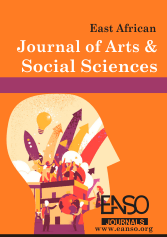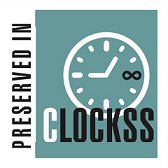‘Matatu’ Graffiti as An Avenue for Self-Expression and Social Commentary Among the Youth in Nairobi, Kenya
Abstract
This paper seeks to examine urban Art in Kenya as an integral part of urban culture with particular emphasis on ‘matatu’ graffiti, (an off-shoot of ‘mural’ graffiti that is depicted on medium-sized vehicles used for urban public transport) as an avenue for self-expression among the youth in Nairobi, Kenya. It will also examine other forms of related art, such as the genre of painting referred to as street art and explore the genesis of themes and subject matter that interest the youth. In order to generate a chronology of thoughts, the paper approaches the above first from the broad spectrum of urban culture and what it entails and then breaks it down to one of the most critical and visible elements of urban culture which is urban Art which, in turn, encompasses many forms of visual creativity both in two dimensional and three-dimensional dispensations that manifest themselves within an urban environment. The paper delves substantively on the generation of broad themes that form the basis of varied subject matters that are regularly depicted in matatu graffiti. These broad themes often derive or emanate from sociocultural, socioeconomic, religious and political factors. The paper also examines the age bracket (herein referred to as The Youth) which embraces urban Art both in terms of its execution and its consumption as well as the underlying factors that seem to make it broadly attractive and acceptable as a means of self-expression, collective discourse and social commentary among the youth. The paper finally examines the relationship between matatu graffiti and hip-hop, a genre of music characterized by terse verbal symbolism and which is increasingly associated with urban culture and the complexities of social expression in the contemporary urban world.
Downloads
References
Barrett, T. (1994) Criticizing Art: Understanding the Contemporary. Mayfield Publishing Company, Mountain View, California.
Chang, J., Forman, M., Neal, M. A., Perry, I., Quinn, E., & Chang, J. (2006). Keeping It Real: Interpreting Hip-Hop.
Forti, D., & Grace, M. (2012). The danger of marginalisation: An Analysis of Kenyan youth and their integration into political, socio-economic life. Nairobi
Ganz, N. (2004). Graffiti World. New York: Abrams.
Gitonga, P. N. (2009). Music as social discourse: the contribution of popular music to the awareness and prevention of HIV/AIDS in Nairobi, Kenya. Unpublished M. Mus thesis, Nelson Mandela Metropolitan University, Port Elizabeth.
Gray, S. (2015) Graffiti History – 10 important moments: retrieved from https://www.widewalls.ch/graffiti-history-10-important-moments/
Herd, D. (2009). Changing images of violence in rap music lyrics: 1979–1997.Journal of public health policy, 30(4), 395-406.
Hess, H. (2015, January 20). African Graffiti Art - Raising Awareness. Retrieved November 12, 2017, from Widewalls: https://www.widewalls.ch/feature-african-graffiti-raising-awareness-2015/
Keyes, C. L. (2004). Rap music and street consciousness (Vol. 394). University of Illinois Press.
Ley, D., & Cybriwsky, R. (2009). Urban Graffiti as Territorial Markers. Tucson, 22-32.
Mallon, S. (2012) Visual Content Creation Ideas to Add Punch and Power: retrieved from http://contentmarketinginstitute.com/2012/12/add-power-visual-content-creation/
Manco, T. (2005). Lost Art & Caleb Neelon. London: Thames and Hudson.
Nganyi, W. A. (2009). Kenyan hip-hop as a site of negotiating urban youth identities in Nairobi. Gottingen: Sierke Verlag.
Oniang'o, M. (n.d.). How Graffiti Artists Are Driving the Matatu Industry in Nairobi. Retrieved from: https://www.africa.com/how-graffiti-artists-are-driving-the-matatu-industry-in-nairobi/
Oyserman, D. (2004). Self-concept and identity. In Self and social identity, eds. Brewer, Marilynn B., and Hewstone, Miles. Blackwell.
Perkins, W. E. (1996). Droppin'science: Critical essays on rap music and hip hop culture. Temple University Press.
Tagg, P. (2000). Analysing Popular Music: Theory, Method and Practice. In R. Middleton (Ed.), Reading Pop: Approaches to Textual Analysis in Popular Music. New York: Oxford University Press.
Umeogu, B. (2013). The Aftermath of Globalization on African Identity. Open Journal of Philosophy, 174-175.
Wambugi, J. (2017). An Introduction to Nairobi's Matatu Culture. Retrieved from: https://theculturetrip.com/africa/kenya/articles/an-introduction-to-nairobis-matatu-culture/
Copyright (c) 2020 Kamau Wango, PhD

This work is licensed under a Creative Commons Attribution 4.0 International License.




























